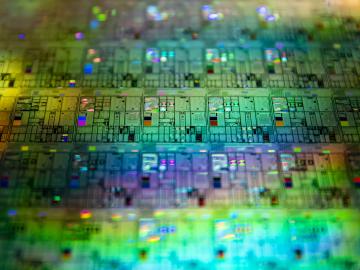
Filter News
Area of Research
- (-) Energy Science (114)
- (-) National Security (29)
- (-) Nuclear Science and Technology (13)
- (-) Supercomputing (52)
- Advanced Manufacturing (7)
- Biology and Environment (46)
- Biology and Soft Matter (1)
- Building Technologies (2)
- Computational Engineering (1)
- Computer Science (10)
- Electricity and Smart Grid (3)
- Energy Sciences (1)
- Functional Materials for Energy (1)
- Fusion and Fission (28)
- Fusion Energy (15)
- Isotopes (1)
- Materials (66)
- Materials for Computing (11)
- Neutron Science (17)
- Quantum information Science (9)
- Sensors and Controls (2)
News Topics
- (-) Chemical Sciences (16)
- (-) Fusion (11)
- (-) Grid (45)
- (-) Machine Learning (28)
- (-) Molten Salt (5)
- (-) Quantum Science (27)
- (-) Security (18)
- 3-D Printing/Advanced Manufacturing (85)
- Advanced Reactors (17)
- Artificial Intelligence (50)
- Big Data (30)
- Bioenergy (31)
- Biology (22)
- Biomedical (24)
- Biotechnology (7)
- Buildings (39)
- Clean Water (8)
- Composites (17)
- Computer Science (117)
- Coronavirus (27)
- Critical Materials (12)
- Cybersecurity (28)
- Energy Storage (74)
- Environment (73)
- Exascale Computing (27)
- Fossil Energy (2)
- Frontier (32)
- High-Performance Computing (46)
- Hydropower (3)
- Isotopes (7)
- Materials (46)
- Materials Science (44)
- Mathematics (4)
- Mercury (3)
- Microelectronics (1)
- Microscopy (14)
- Nanotechnology (15)
- National Security (38)
- Neutron Science (25)
- Nuclear Energy (46)
- Partnerships (16)
- Physics (11)
- Polymers (13)
- Quantum Computing (20)
- Simulation (18)
- Software (1)
- Space Exploration (10)
- Statistics (1)
- Summit (44)
- Transportation (72)
Media Contacts

We have a data problem. Humanity is now generating more data than it can handle; more sensors, smartphones, and devices of all types are coming online every day and contributing to the ever-growing global dataset.

Researchers at ORNL demonstrated that sodium-ion batteries can serve as a low-cost, high performance substitute for rechargeable lithium-ion batteries commonly used in robotics, power tools, and grid-scale energy storage.

The prospect of simulating a fusion plasma is a step closer to reality thanks to a new computational tool developed by scientists in fusion physics, computer science and mathematics at ORNL.

Energy storage startup SPARKZ Inc. has exclusively licensed five battery technologies from the Department of Energy’s Oak Ridge National Laboratory designed to eliminate cobalt metal in lithium-ion batteries. The advancement is aimed at accelerating the production of electric vehicles and energy storage solutions for the power grid.

A team from the ORNL has conducted a series of experiments to gain a better understanding of quantum mechanics and pursue advances in quantum networking and quantum computing, which could lead to practical applications in cybersecurity and other areas.

A typhoon strikes an island in the Pacific Ocean, downing power lines and cell towers. An earthquake hits a remote mountainous region, destroying structures and leaving no communication infrastructure behind.

Oak Ridge National Laboratory researchers created a geothermal energy storage system that could reduce peak electricity demand up to 37% in homes while helping balance grid operations.

To better determine the potential energy cost savings among connected homes, researchers at Oak Ridge National Laboratory developed a computer simulation to more accurately compare energy use on similar weather days.

As scientists study approaches to best sustain a fusion reactor, a team led by Oak Ridge National Laboratory investigated injecting shattered argon pellets into a super-hot plasma, when needed, to protect the reactor’s interior wall from high-energy runaway electrons.

A technology developed at the ORNL and scaled up by Vertimass LLC to convert ethanol into fuels suitable for aviation, shipping and other heavy-duty applications can be price-competitive with conventional fuels


